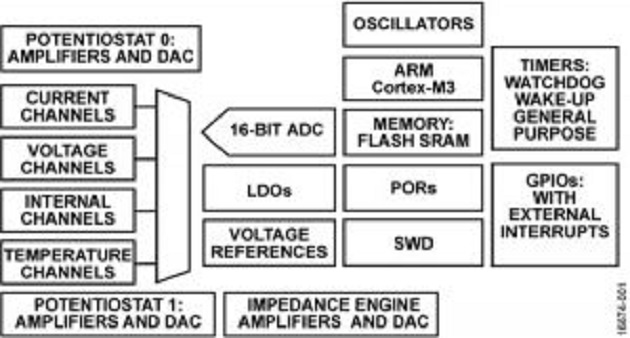ADuCM355, as it is known, is aimed at applications such as industrial gas sensing, instrumentation, vital signs monitoring and disease management.
Effectively the chip is an Arm Cortex-M3 microcontroller with specialised high-performance analogue peripherals, and the use of ‘high-performance’ is justified here. For example, the dual “ultra-low power, low noise”, according to the company, some of the DACs consume only 1μA and ADC noise below 10uV for some filter setting – there is a detailed breakdown of noise and filtering in the data sheet.
Central to ADC activity is a 16bit, 400ksample/s successive approximation register converter with input buffers, a built-in anti-alias filter and programmable gain amplifier. Inputs are either voltage, current or impedance, and for these three trans-impedance amplifiers are included with programmable gain and load resistors for measuring different sensor types.
Potentiostat input amplifiers maintain a constant bias voltage for an external electrochemical sensor, and the non-inverting inputs of these two amplifiers are controlled by on-chip DACs. On top of this there is an internal higher speed DAC and output amplifier for generating ac signals up to 200kHz.
Internal channels connected to the ADC multiplexer allow diagnostic measurements of the internal supply voltages, die temperature, and reference voltages – precision 1.82V and 2.5V are available on-chip.
Processing comes from the Cortex-M3 clocked at 26MHz (32.5DMips peak) with a multi-channel
direct memory access controller, 128kbyte of flash/eeprom and 64kbyte of sram. Clocking is actually flexible and the 26MHz can be wound down to save power – the logic for this is included. There is also a power-saving internal 32kHz oscillator that can clock the internal timers. Via general-purpose I/O, these timers can also produce PWM waveforms.
With security upper-most in everyone’s mind, or at lease it should be, hardare has been included for crypto acceleration (AES-128 and AES-256), CRC (cyclic redundancy check), polynomial generation and read/write protection of user flash.
On-chip factory firmware supports in-circuit erasing of user flash triggered via the UART, according to ADI, while non-intrusive emulation and program download are supported via the serial wire debug port.
Operation is over 2.8V to 3.6V and -40°C to +85°C.
Packaging is 72 lead 6mm x 5mm LGA (land grid array).








